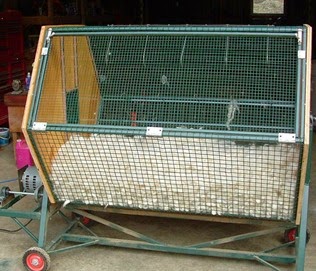All About Alpaca
 |
| Bella from Granny's Alpacas |
Alpaca
was the first fiber that I ever got my hands on as a spinner. I
remember being amazed at how one breed could have such a wide variety of
fiber, and how most of it was not scratchy the way I have come to know
most commercially bought woolen garments to be.
Eco-Friendly Fluffy Friends!
Cleaning Their Fleece:
 |
| Fleece Tumbler |
A tumbler is an absolute must-have if you have a herd of alpacas and don't want to spend hours and hours picking through their fiber! When we first started Blue Barn Fiber, I picked through 200 pounds of alpaca blankets by hand and removed the VM the hard way. I learned very quickly that sometimes expensive investments are worth the money -- but when you don't have a lot of money to spend, you can definitely get things done the old fashioned way.
Fiber Grades
 |
| Rivendell Meadows Alpacas & Angoras |
It is important to note that not all alpaca fiber is created equally! Alpaca fiber is semi hollow, which means that it is an amazing insulator. It is significantly warmer than wool, and it is also very light weight due to the structure of the fibers. Unlike wool and cotton, alpaca has natural hydrophobic properties, meaning that it wicks the water out instead of absorbing it. Alpaca also does not have the microscopic barbs that wool has, which often causes that prickly sensation. For that reason, alpaca fiber that is 21 microns (for example) will likely feel much softer and smoother than wool that is also 21 microns.
Alpaca comes in 6 different grades, grade 1 being the most luxurious and softest, grade 6 being on the coarser side.
- Grade 1 Ultra Fine, or Royal Baby alpaca. It is less than 20 microns, and feels like butter in your hands! Equivalent to cashmere.
- Grade 2 Superfine / Baby: falls within 21 and 22.9 microns. Still absolutely heavenly soft and can be worn on your naked skin.
- Grade 3 Fine: 23-25.9 microns. Soft, versatile, suitable for a wide variety of projects and garments.
- Grade 4 Medium: 26-28.9 microns. Good for blankets, socks, non-sensitive areas of the skin.
- Grade 5 Intermediate: 29-32 microns. Less soft, more for outerwear, quilts, that sort of thing.
- Grade 6 Adult Grade: 32-35+ microns.Strong, not soft. Best for rugs and things that need a lot of durability.
Suri Vs. Huacaya
There are two types of Alpacas, and both have very unique characteristics.
An oversimplification would be to state that one breed is long haired and the other short
haired. But it's not quite as simple as that.
falls flat and moves freely. They have distinct separate sections of locks (which are referred
| Double D Alpaca Ranch - Illuminatus, Suri Alpaca |
Pure Bred Suri Alpacas should not ever have any crimp in the
staple, meaning that you would want to use it for a garment
memory (at least not without blending it).
Spun
correctly, Suri alpaca is absolutely amazing. It has the softness of
cashmere with the luster of silk. It is an extraordinary fiber from
beautiful animals, but it is not a fiber meant for beginners.
 |
| Alpacas of the North Country |
Huacaya Alpacas are more common but just as extraordinary as Suris. Before being sheared, they tend to have a teddy-bear appearance that makes
them quite huggable ! A good Hyacaya fleece should be uniform, very
dense, and grow perpendicular to the skin, creating that characteristic
fluffy appearance that Suris lack.
 |
| Huacaya Crimp, courtesy of Great Northern Ranch |
There are 22 different shades of natural alpaca fiber, and the vast differences between breeds and grades of fleece means that Alpaca could potentially be used for
just about any project you can think of. It is one of my very favorite
types of fiber to work with due to its universal nature, and the fact
that these animals are so cute is just a bonus.